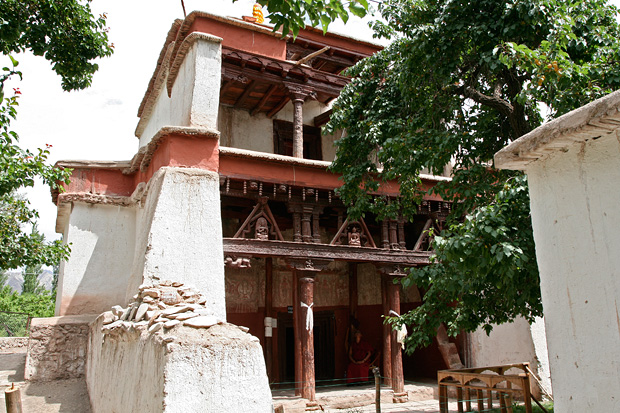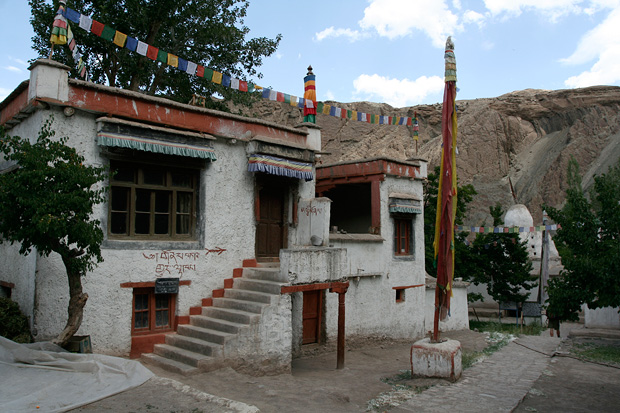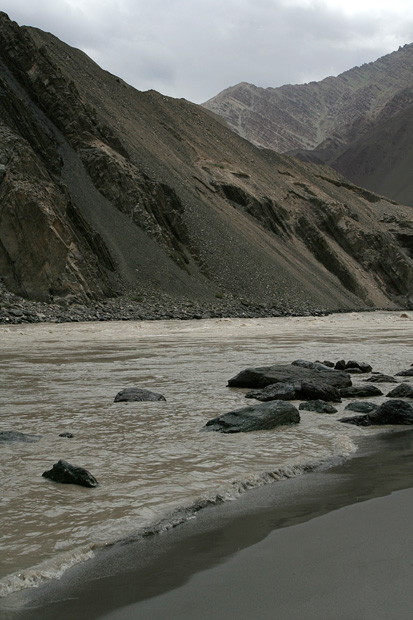Ladakh – Monasteries – Alchi Monastery
I went to Alchi Monastery looking for the ancient paintings of a distinct style that sets it apart from other religious centers in Ladakh. Trees laden with apricots and the swift flowing Indus River were an added bonus.
My bus passed through lush green oasis of saspol village on its way to Alchi. After two hours on the road west of Leh along the Indus River, the bare mountainscape temporarily made way for a relatively flat terrain teeming with apricots and apples amidst barley fields. The apricots trees with numerous fruits looked more yellow than green. Apple trees were irresistibly red.
Just across the river, Alchi Village has one of the oldest standing structures anywhere in Ladakh. The Alchi choskor or the ‘religious enclave’ is dated approximately to eleventh century and has an architecture very unlike other monasteries in the region. It was abandoned as a place of worship and remained unknown to rest of the world, till historians unearthed the treasured paintings in the choskor only a few decades ago. On hindsight, its desertion seems to have worked well in its preservation. The monastery escaped destruction from Kashmiri invaders four centuries years ago as much as it escaped renovation and restoration from the Ladakhi monks.

Sum Tsek at Alchi Monastery
Walking past the small village and along a narrow path on the banks of Indus, I entered the monastery that wore a deserted look. It did not have the usual buzz of playful kid-monks running along the corridor chasing each other or the smiling elderly lamas in ochre robes walking slowly as they chanted some mantra. Also missing were the randomly built living quarters that usually spread around the prayer hall, the quadrangle where the festivals are held and the colourful paintings on the front walls. The choskor looked more like a bunch of randomly built houses with a few apricot trees surrounding them.
The drab exteriors though, are a contrast to the colourful inner walls. Once inside, I see every inch of the wall covered with small paintings. The sum-tsek—the main temple in Alchi—is a three story building with colourful paintings in its inner walls. It takes some time to get used to the interiors kept dark to preserve the paintings. The colours start coming alive as the eyes slowly get accustomed to the darkness. The walls are covered from end to end with thousands of small colourful images of Buddha. At the center of three inner walls are three-story high statues of incarnations of Buddha—Avalokiteshwara, Maitreya and Manjushree. The upper half of the Buddha statues are not visible from below, as they stand above the first floor where the weakening structure doesn’t permit access.

A section of the monastery
At the neighbouring prayer hall are equally colourful but a diverse variety of paintings that include a sailing ship, people wearing clothes that look Central Asian and other secular images that are evidently not Ladakhi. The paintings in Alchi vary considerably from other monasteries influenced by Tibetan culture and its animist origins. It doesn’t carry the extraordinary characters and stylization with demonic and unearthly features commonly seen on the walls of most other monasteries. On the contrary, they are said to bear resemblance to Buddhist paintings from the Indian plains, indicating that Alchi was perhaps built in a time when a wave of Buddhist preachings spread into Ladakh from Kashmir and North India. Historians often refer to this as ‘second spreading of Buddhism’ against the first arrival of the religion in Ladakh from Tibet. Among the Himalayan Buddhist centers, only other surviving monastery with paintings similar to Alchi are found in Tabo Village in Lahaul and Spiti. Both monasteries are now in the tentative list of UNESCO World Heritage sites.

Just outside the monastery, Indus River flows swiftly in a depression carved by its currents. I walked down to the river bank and spent some time watching its fast flowing muddy current before making my way back to Leh in the evening.
Information
The Alchi choskor complex has five buildings. The sum-stek or the three story temple has three-story high statues of Avalokiteshwara, Maitreya and Manjushree, with its walls painted with thousands of small Buddhas. The dukhang or the main prayer hall is larger with two sections and has many secular and religious paintings. The Manjushri Lhakhang, Lotsawa Lhakhang and Lhakhang Soma are the smaller temples.
Alchi Monastery is known for the historical value and uniqueness of the paintings. It is no longer in use as a religious place, though it is maintained and managed by the monks of nearby Likir Monastery.
How to reach. Alchi is 65km from Leh downstream Indus. Most tourists hire a cab to get there, though Alchi is well connected by public transport from Leh (about 3 hours). If you are taking a bus from Leh, it is better to be informed about the timings beforehand. Ask your hosts in Leh or check at the bus-stand a day before.
Food and Accommodation. If you are on a day-trip from Leh, Alchi Village has a few restaurants just outside the monastery. In front of the the choskor is a place run by Likir Monastery, where food and accommodation is available. There are a few more guesthouses and hotels available in Alchi for those who would like to stay at the village.
Map and driving directions.
View Leh to Alchi in a larger map